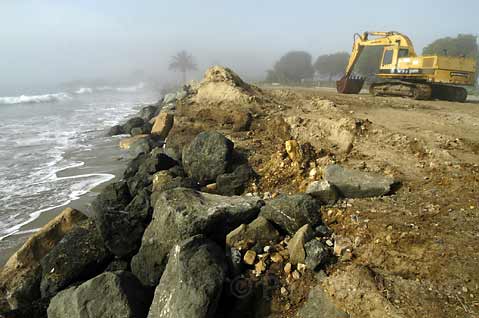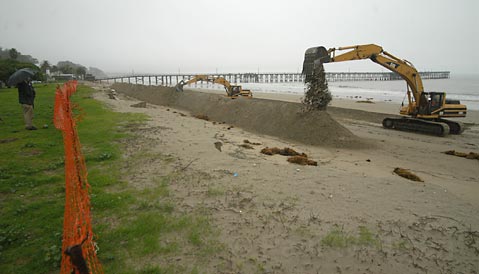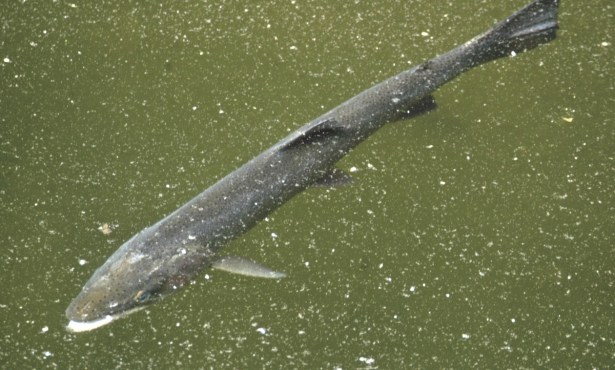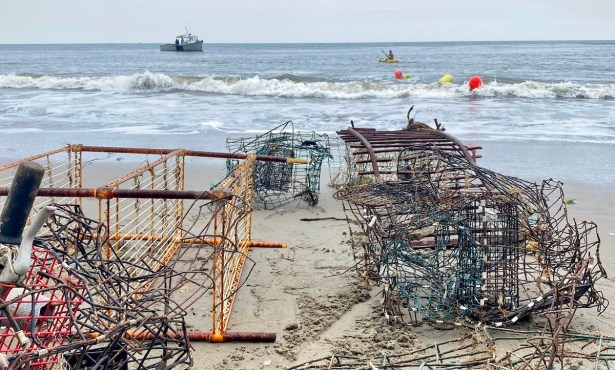Coastal Commission Denies Permeable Pile Pier
County Back to Drawing Board for Goleta Beach Erosion Control

Against the recommendation of its own staff, the California Coastal Commission voted 9-1 on Wednesday to deny Santa Barbara County’s proposal to build a permeable pile pier – a structure designed to slow the effects of beach erosion by holding sand on the beach – along the wharf at Goleta Beach.
After facing several El Ni±o storms over the past decade, erosion at Goleta Beach has prompted community concern for the future of its most heavily visited public park, and some supporters now call for drastic measures to save it. On most weekends throngs of people can be seen relaxing on the park’s green lawns and sandy beach, and public sentiment has been largely in favor of protecting it. Although the county was singularly dedicated to developing the permeable pile proposal, the Environmental Defense Center (EDC) and the Santa Barbara Chapter of the Surfrider Foundation have sought an alternative with fewer environmental impacts. They propose an alternative initially called a “managed retreat” and more recently “park reconfiguration,” which appears to have driven the final nail in the coffin of the proposed pile pier.
“This is a big surprise to us. We thought that because of staff approval, we’d just get a nod to get approved and go home,” said Dave Hardy, co-owner of the Beachside Cafe. Situated at the base of the pier, Hardy’s business has perhaps more to lose than others weighing in on the situation.
The Coastal Commission’s final verdict was not the only surprise during Wednesday’s proceedings. At the last minute, Coastal Commission alternate Dr. Dan Secord unexpectedly recused himself because of his supportive comments he made public on July 2. “I went to Goleta City Council and advocated for the project, and that wasn’t the proper thing to do, so I had to recuse myself,” he said.
Some environmental activists offered public comments at this week’s Coastal Commission hearing that significantly swayed Wednesday’s vote. Often, some commissioners will defer their vote to the commissioner of the region that the vote will affect. However, Secord indicated otherwise. “The vote was 9-1, and if I’d been there, it would have been 9-2,” he said.

While a park reconfiguration solution was not being considered as an option by Santa Barbara County, EDC and Surfrider mounted a relentless campaign to bring it to the attention of Coastal Commissioners. The environmental groups hired Dr. David Revell of Phillip Williams & Associates – an environmental hydrology firm – and a number of other experts to conduct an independent study comparing their proposal against the county’s. According to them, the results made their alternative all the more appealing, with lower costs and fewer impacts on the beach and its guests. Though county officials disagreed with the numbers produced by Brian Trautwein, EDC’s environmental analyst, Trautwein indicated that the permeable pile project would cost about $2 million more just to start up than the park reconfiguration alternative. In addition, ongoing maintenance over the next decade would total more than $20 million for the permeable pier, compared with $8.4 million for park reconfiguration.
Aside from the cost, a number of other concerns were brought up by environmental activists and others who made the trip to San Luis Obispo’s county administration building. “Your handling of this will set precedent for statewide seawall construction,” said Mark Massara, who represented the Sierra Club in the matter. “This is like putting a picnic table on top of an unpermitted sea wall. And for what? For a lawn and a utility line,” he said, adding that sea level rise was not taken into account.
Speaking on behalf of the Goleta City Council, Councilmember Michael Bennett spoke in favor of the permeable pier, voicing his agency’s worries that the popular beach would disappear without intervention.
Referencing the many ruins of coastal armoring structures seen all over California’s coast, UCSB physics professor Everett Lipman looked at the potential legacy of a coastal protection structure that is not maintained. “Whenever I scrape myself on one of those rusty I-beams, I remind myself that once upon a time, some coastal engineer convinced some policy maker that this was the best solution,” he said.
This is not the first time hard structures have been suggested for coastal protection at Goleta Beach. Over the last few decades, storm damage has threatened the integrity of asphalt parking surfaces, utility lines, bathroom structures, and the Beachside Cafe at Goleta Beach. The county’s response has been immediate coastal armoring in the form of rock piles along the edge of the beach nearest the grass, which tenuously protected beachfront infrastructure as coastal sands were quickly washed away by the strength of winter storms. Key detractors of this approach, EDC and Surfrider decried what they said was unpermitted placement of the rocks, citing their belief that it caused further erosion downcoast from Goleta Beach, and objecting to the county’s failure to remove the rocks once the seasonal rough weather patterns subsided.
In its first evolution, mitigation measures proposed during nearly a decade of community meetings and workshops included rock walls extending out into the water, offshore rock walls, more dredging, an artificial headland at the end of the beach closest to UCSB, and managed retreat. That last option was dismissed by the county as giving up land area at the highly trafficked park, but stone structures were seen as too heavy-handed a solution to the problem of beach erosion. When Moffatt & Nichol, the engineering firm in the county’s employ, offered the permeable pile option, it was lauded as an innovative approach. Environmental groups were still not convinced.
The Coastal Commission’s staff, after what they described as a thorough review process, recommended the permeable pile pier, but with 18 conditions, covering everything from potential impacts to environmentally sensitive habitat areas to the type of dredging equipment that would be used. “This is one of the most heavily conditioned projects we’ve ever had,” said Jonna Engel, the commission’s staff ecologist, adding that staff was extremely thorough in its gathering of information from Moffatt & Nichols.
In order to obtain more detailed information about the area where sand was to be dredged for beach nourishment, Engel said that the Coastal Commission staff required Moffatt & Nichol to hire scuba divers to take core samples of the sandy bottom in order to more accurately determine its makeup.
Commissioners one by one expressed their interest in what they said was an experimental but innovative permeable pile pier project, but that they needed more information and physical modeling to commit to it. “To be pithy for a second, I don’t think we should think with our groins,” said Commissioner Ross Mirkarimi, who, along with other commissioners, expressed his reservation that the permeable pier is the best way to protect the beach.
Although a motion was made to continue the project, Coastal Commission staff said that they had worked on it enough, and did not feel that dedicating more time and resources to it would be productive. In addition, neither the county nor most of the commissioners wanted to continue either, so the project was voted down by all except Commissioner Khatchik Achadjian.
“There are a lot of pissed-off stakeholders out there that are going to want nothing to do with managed retreat,” said Santa Barbara County Parks Director Dan Hernandez after the decision was handed down, noting that essentially, it’s back to the drawing board for the county. John Baker, Santa Barbara County’s Assistant CEO, stormed from the room after the proceedings concluded.
Trautwein said that, at this point, EDC and Surfrider would like to work with the county to come up with something everyone can agree on. “We would like to find an alternative solution that protects the park, the beach, and the environment,” he said. “Today, the commission upheld the Coastal Act. It was a victory for our beaches and for people who love beaches.”



